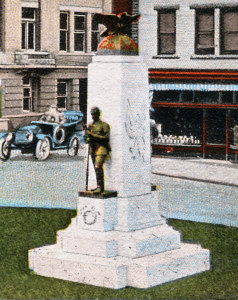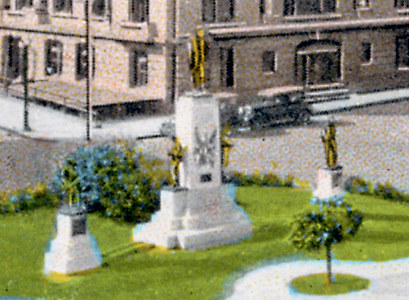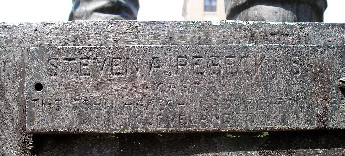

Alliance Soldiers’ Memorial (1924)
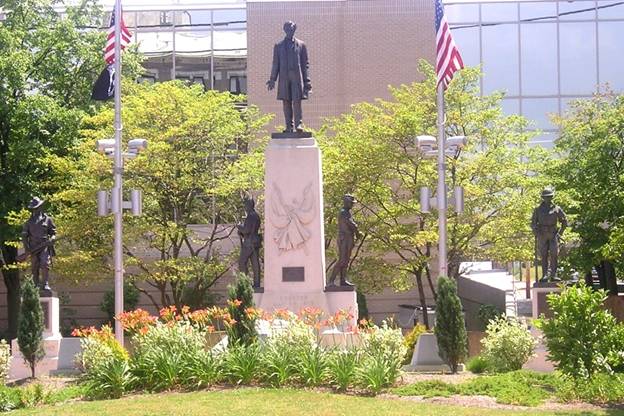
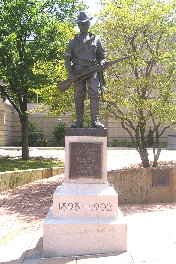
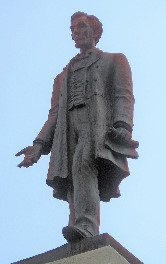
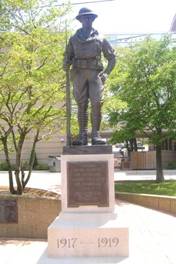
Sculpted by Rebeck, left to right are a Spanish-American War soldier; Abraham Lincoln and a WWI Doughboy
On May 30, 1915, the City of Alliance dedicated a Civil War Memorial.. It consisted of the two Civil War soldiers on the sides of center pedestel with an eagle where Lincoln now stands. From a 1917 postcard, the location was in the center of town: (click for full postcard).
In 1922, the local Grand Army of the Republic Post decided on replacing the eagle with the figure of Abraham Lincoln. Curtis B. Maxwell, commander of the local United Spanish War Veterans decided that a memorial for that war should be included.
A committee was formed and the result is the current memmorial. Steven Rebeck was commissioned to sculpt a figure from the Spanish-American War (Far Left), Abraham Lincoln (center), and a Doughboy representing World War I (far right). To fund the project, 3000 watch fobs, bearing the likeness of the monument were sold. The Spanish War and Doughboy figures each cost $2,300 while the nine foot Lincoln was $3,500. The statues were cast by the John Harsch Bronze Foundry Company of Cleveland.
Below is an undated vintage postcard showing the new arrangement (click for the full postcard for context).
The memorial was officially dedicated on July 4, 1924 remaining in the center of Alliance but moved at an unknown year to Freedom Park "between 513 East Main and 449 East Main" per the Alliance Park Director. This park is displayed in the pictures at the top of this segment and is it's current location in Alliance, Ohio.
The statue of Abraham Lincoln is one of the works Steven Rebeck was most proud of.
“These monuments you dedicate here are in honor of scrifices on the battlefield, ocean and in the hospital. This is a monument to Stark county which sent it’s full quota not only to the Civil but the Spanish-American and World wars,” Gen. Blodgett told the veterans in delivering the Lincoln dedicatory address. Blodgett, on of the boys to answer Lincoln’s call for volunteers, gave intimate glimpses of the Emancipator’s life. The two had lived in the same town. Years later, Blodgett was in touch with Lincoln’s political battles, and following the martyred president on several of his tours. Speaking of the Lincoln statue, the speaker stated it was a likeness of the president after he had signed the Emancipation proclamation, liberating the slaves of the south. “And the Union forces did not win a battle until the slaves had been freed,” Blodgett stated. (Alliance Review, July 5, 1924)
REFERENCES:
“Relate Story of Struggles to Erect Memorial to Heroic Dead of Three Great Wars as Day to Dedicate Alliance’s Great Monument Nears,” Alliance Review, June 18, 1924.
“Rain Mars Unveiling,” Alliance Review, July 5, 1924.
Mead, Franklin B. Heroic Statue in Bronze of Abraham Lincoln. Fort Wayne: The Lincoln National Life Foundation, 1932, p. 57, 84.
Durman, Donald Charles. He Belongs to the Ages. Ann Arbor: Edward Brothers, 1951, p. 190-191.
“He Carved a Name for Himself,” Cleveland Press, October 1, 1971.
Pictures by Dave Rebeck
